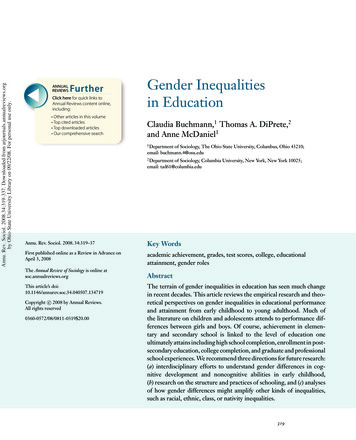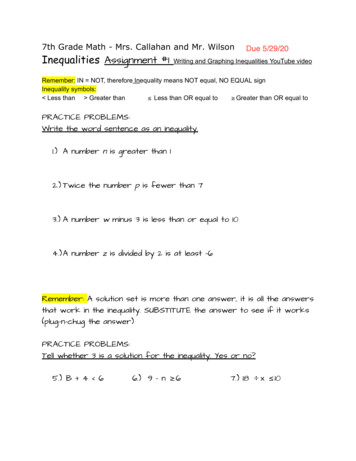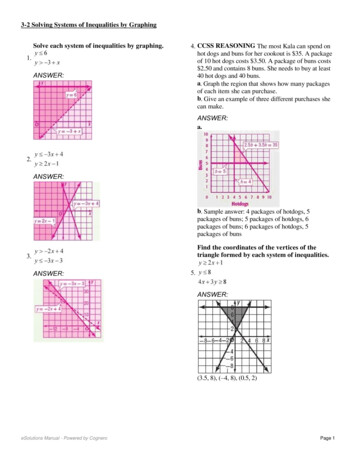
Transcription
Annu. Rev. Sociol. 2008.34:319-337. Downloaded from arjournals.annualreviews.orgby Ohio State University Library on 09/22/08. For personal use only.ANNUALREVIEWSFurtherClick here for quick links toAnnual Reviews content online,including: Other articles in this volume Top cited articles Top downloaded articles Our comprehensive searchGender Inequalitiesin EducationClaudia Buchmann,1 Thomas A. DiPrete,2and Anne McDaniel11Department of Sociology, The Ohio State University, Columbus, Ohio 43210;email: buchmann.4@osu.edu2Department of Sociology, Columbia University, New York, New York 10025;email: tad61@columbia.eduAnnu. Rev. Sociol. 2008. 34:319–37Key WordsFirst published online as a Review in Advance onApril 3, 2008academic achievement, grades, test scores, college, educationalattainment, gender rolesThe Annual Review of Sociology is online atsoc.annualreviews.orgThis article’s doi:10.1146/annurev.soc.34.040507.134719c 2008 by Annual Reviews.Copyright All rights reserved0360-0572/08/0811-0319 20.00AbstractThe terrain of gender inequalities in education has seen much changein recent decades. This article reviews the empirical research and theoretical perspectives on gender inequalities in educational performanceand attainment from early childhood to young adulthood. Much ofthe literature on children and adolescents attends to performance differences between girls and boys. Of course, achievement in elementary and secondary school is linked to the level of education oneultimately attains including high school completion, enrollment in postsecondary education, college completion, and graduate and professionalschool experiences. We recommend three directions for future research:(a) interdisciplinary efforts to understand gender differences in cognitive development and noncognitive abilities in early childhood,(b) research on the structure and practices of schooling, and (c) analysesof how gender differences might amplify other kinds of inequalities,such as racial, ethnic, class, or nativity inequalities.319
INTRODUCTIONAnnu. Rev. Sociol. 2008.34:319-337. Downloaded from arjournals.annualreviews.orgby Ohio State University Library on 09/22/08. For personal use only.Just over a decade ago, Jacobs (1996, p. 156)noted that the literature on gender inequalities in education “often treats all aspects ofeducation as disadvantaging women.” This assessment is less valid today, as much researchnow examines the ways in which girls andwomen are advantaged in some aspects of education, as well as those in which they continue to trail boys and men. Although girlshave long gotten better grades in school thanboys, most researchers brushed aside this pointbecause women did not translate their betterperformance into higher levels of educationalattainment relative to men (Mickelson 1989).But as women have come to far outnumber menamong new college graduates in most industrialized societies, new questions about genderinequalities in education have emerged.This article provides a selective, crossdisciplinary review of the literature on genderinequalities in educational performance and attainment from early childhood to young adulthood. We map the terrain of current genderinequalities for a wide range of educational indicators, we discuss the theoretical perspectivesthat have been used or could prove useful for explaining these inequalities, and we suggest howfuture research could advance understandingof the complex nature of differences betweenmales’ and females’ educational experiences.Most research assumes that individualsprogress through the educational system in a sequential mode and that early school experiencesset the stage for those that follow (Pallas 2003).Research also tends to be bifurcated betweenthat focused on educational outcomes and experiences during childhood and adolescence (corresponding with primary and secondary school)and that focused on educational attainment andhigher education. Following these tendencies,we structure this review into three sections. Inthe first, we assess the current state of knowledge regarding gender inequalities in primaryand secondary school, from children’s earliestexperiences with formal schooling, as they enter kindergarten through the end of compulsory320Buchmann·DiPrete·McDanielschooling, which in most industrialized societies is the end of secondary school. This sectionfocuses on educational achievement, as muchof the literature on gender differences duringchildhood and adolescence attends to performance differences between girls and boys. Ofcourse, performance in elementary and secondary school is linked to the level of schoolingone ultimately attains. The second section provides an empirical overview of gender inequalities in young adulthood and beyond in terms ofeducational attainment, including high schoolcompletion, enrollment in postsecondary education, college completion, and graduate andprofessional school experiences. The pathwaysthat individuals take from high school to college and the completion of a college degreevary greatly (Goldrick-Rab 2006). Within thisapparently endless variation, however, there aregendered patterns that demand examination. Inthe third and final section, we offer several fruitful directions for future research.Because we focus on formal schoolingbounded by entry into kindergarten throughcompletion of college, we do not consider research on gender differences in very early childhood and preschool (see Kraft & Nickel 1995for a review) or continuing and adult education ( Jacobs & Stoner-Eby 1998, Jacobs &King 2002). We focus on U.S.-based researchbut incorporate literature from other industrialized countries and cross-national researchwhere noteworthy. Patterns of gender inequalities in developing societies are quite differentfrom those in most industrialized societies, andspace limitations preclude us from consideringthis important topic here (but see King & Hill1993, Buchmann & Hannum 2001).FROM KINDERGARTENTHROUGH HIGH SCHOOLIn the United States, most children start formalschooling at age 5, but approximately 10% ofchildren begin kindergarten a year later. Parents decide when their children begin schooland, along with teachers, determine whetherchildren are promoted to the next grade.
Annu. Rev. Sociol. 2008.34:319-337. Downloaded from arjournals.annualreviews.orgby Ohio State University Library on 09/22/08. For personal use only.Delayed entry into kindergarten, or academicredshirting, is more common among boys andamong children from families of high socioeconomic status (SES) (Graue & DiPerna 2000).Nationally representative data from the EarlyChildhood Longitudinal Study of the Kindergarten Cohort (ECLS-K) indicate that boyscomprise about 60% of the children with delayed kindergarten entry and 66% of those whorepeat kindergarten (Malone et al. 2006). Boysare also more likely than girls to be retaineda grade or more during elementary school(Alexander et al. 2003, Entwisle et al. 2007).These differences in early school trajectoriesare important to bear in mind when comparingboys and girls in terms of their academic performance. In age-based comparisons, girls willhave attained a slightly higher average gradelevel than boys. In grade-based comparisons,most common in research, boys will be slightlyolder on average than girls. The matter is madeeven more confusing owing to the differentdevelopmental trajectories of girls and boys,with girls tending to mature more quickly thanboys (Tanner 1978, Gullo & Burton 1992). Onecould argue that comparisons using chronological age ignore sex differences in maturationaltempo and result in comparing more maturegirls to less mature boys (Eaton & Yu 1989), yetthese complexities are infrequently consideredin the literature.Gender Differences inAcademic PerformanceMany researchers, educators, and politicians regard academic performance as the bottom linein K-12 education. From parent-teacher associations meetings to the national No Child LeftBehind Act, the question “how are our children doing?” is usually addressed with data fromstandardized tests and other uniform assessments or grades and report cards. When thequestion turns to “who is doing better, girls orboys?” the answer depends on the age of students being compared and whether grades ortest scores are used. The two measures capturedifferent elements of academic performanceand ability, as is evident by the generalization that males tend to obtain higher scores onstandardized tests, whereas females tend to gethigher grades (Duckworth & Seligman 2006).Most of the literature on academic performancefocuses on adolescents, but the recent availability of data for younger children (such as theECLS-K) has stimulated research on performance earlier in childhood.Early ChildhoodLongitudinal Study,KindergartenCohort: the ECLS-Kfollowed children whobegan kindergarten in1998/1999 and theirprogression througheighth gradeTest scores. Gender differences in test scoreshave been the subject of much research formany decades. Maccoby & Jacklin’s (1974) important book The Psychology of Sex Differencesprovided a comprehensive analysis of morethan 1600 studies in the areas of achievement,personality, and social relations and served tostimulate much interest and new research ongender differences in achievement in particular. Despite the large literature in this area (seeWillingham & Cole 1997 for a review), disagreement remains on several fronts, including when in the life course gender differencesin math performance emerge (Leahey & Guo2001), whether males are more variable than females on measures of achievement (Willingham& Cole 1997), and whether sex differences intest scores are declining over time. Some researchers argue that gender gaps in test scoreshave narrowed in recent decades (Feingold1988, Hyde et al. 1990), but on the basis of theirmeta-analysis of test results for writing, math,and science, Hedges & Nowell (1995) concludethat gender gaps in test scores have remainedrelatively stable over the past 30 years.Results from various national and international large-scale assessments indicate that boyshave higher test scores in mathematics andgirls have higher test scores in reading (Baker& Jones 1993, Beller & Gafni 1996, Nowell& Hedges 1998, Gallagher & Kaufman 2005,Marks 2007), but there is considerable crossnational variation in the size of these gaps (A.M.Penner, unpublished observations). There isalso a life course component to gender differences in test scores; research consistently findsgenerally similar performance of girls and boysin mathematics and reading in the early gradeswww.annualreviews.org Gender Inequalities in Education321
Annu. Rev. Sociol. 2008.34:319-337. Downloaded from arjournals.annualreviews.orgby Ohio State University Library on 09/22/08. For personal use only.and a growing male advantage in math scoresand growing female advantage in reading scoresas they move through school (Maccoby &Jacklin 1974, Willingham & Cole 1997). Thesegender-based performance differences persistin standardized tests, such as the SAT, usedin higher education admissions, although theytend be small and the distributions of male andfemale scores overlap substantially (Hyde 2005,Kobrin et al. 2007). Inferring gender differences in math and verbal abilities from gender differences in SAT scores is problematicbecause the sample of SAT test takers is notrepresentative of the general population and because more females than males take the SAT,so the sample of males is more highly selected(Spelke 2005).Some evidence suggests that gender gapsin test scores are more pronounced amonglow-income children (Hinshaw 1992), but results are not definitive. For example, Entwisleet al. (2007) find that although girls and boysstart first grade with similar reading scores,a female-favorable gap in reading emerges byfifth grade, but only for children from economically disadvantaged families; boys and girlsfrom middle- and upper-class families had verysimilar reading scores. Conversely, with nationally representative data, T.A. DiPrete &J. Booher-Jennings (unpublished observations)find that girls have higher reading scores thanboys across all levels of SES.Grades and behaviors related to school success. Girls have long obtained higher grades inschool than boys. Even in the 1950s and 1960sgirls earned higher grades than boys and hadhigher class standing in high school (Alexander& Eckland 1974, Alexander & McDill 1976,Mickelson 1989). Today, from kindergartenthrough high school and even in college, girlsget better grades in all major subjects, includingmath and science (Perkins et al. 2004).As early as kindergarten, girls have moreadvanced reading skills than boys (West et al.2000, Tach & Farkas 2006), and boys continue to have more problems with reading inelementary school (Trzesniewski et al. 2006).322Buchmann·DiPrete·McDanielBoys are overrepresented in populations withreading disabilities, antisocial behavior, mentalretardation, attention disorders, dyslexia,stuttering, and delayed speech (Halpern 1997,Muter 2003, Rutter et al. 2004). Moffitt et al.(2001) find that males are at higher risk forantisocial behavior that is neurodevelopmentalin origin, but for antisocial behavior thatoriginates in the context of social relationships,gender differences are negligible. Trzesniewskiet al. (2006) demonstrate that antisocial behavior and reading difficulties go hand in hand forboys; antisocial behavior leads to poor readingskills and vice versa. Emotional and behavioralproblems early in childhood also contribute toeducational outcomes later in life, such as thelikelihood of repeating a grade in secondaryschool, completing high school, and enrollingin college (Shanahan 2000, McLeod & Kaiser2004).Girls also have advantages in social skillsand classroom behavior. Analyses of ECLS-Kdata find that as early as kindergarten, “boysdisplay more developmental disabilities, moredisruptive conduct in class and less positive orientations to learning activities” (Zill & West2001). For example, according to parent andteacher reports, twice as many boys as girlshave difficulty paying attention in kindergarten,and girls more often demonstrate persistencein completing tasks and an eagerness to learn.These advantages in orientation to learning andother social skills grow during the early elementary school years and plausibly account for aportion of the more rapid reading gains thatgirls achieve during this period (T.A DiPrete& J. Booher-Jennings, unpublished observations). During adolescence, high school teachers consistently rate girls as putting forth moreeffort and as being less disruptive than boys(Downey & Vogt Yuan 2005). Adolescent girlsalso possess higher levels of other noncognitive skills such as attentiveness and organizational skills (Farkas et al. 1990, Jacob 2002),self-discipline (Silverman 2003, Duckworth &Seligman 2006), leadership qualities, and interest in school, all of which facilitate academicsuccess (Rosenbaum 2001). These gender
Annu. Rev. Sociol. 2008.34:319-337. Downloaded from arjournals.annualreviews.orgby Ohio State University Library on 09/22/08. For personal use only.differences in noncognitive skills may be central in explaining why boys get higher test scoresin some domains but girls generally get highergrades. Farkas et al. (1990) show that teachers’ judgments of students’ noncognitive characteristics are powerful determinants of coursegrades even when cognitive performances arecontrolled.Finally, in areas where females once laggedbehind males in the rigor of their high schoolcoursework, they now outpace males. Until recently, girls trailed boys in the number and intensity of the mathematics courses they took.Now boys and girls take equally demandingmath classes in high school (Catsambis 2005),and girls get better grades in those classes(Gallagher & Kaufman 2005). Female highschool graduates are more likely to have takenbiology and chemistry courses than males (Xie& Shauman 2003). Girls have also come to outpace boys in the number of college preparatorycourses and Advanced Placement examinationsthey take (Bae et al. 2000, Freeman 2004). Girlsare more involved in extracurricular activities,with the notable exception of participation onathletic teams (Bae et al. 2000), and they participate in more cultural activities within andoutside of school (Dumais 2002). All these advantages are related to academic success in highschool, to the likelihood of enrolling in college,and to ultimate educational attainment, as wediscuss in detail below.EXPLAINING GENDER GAPSFROM KINDERGARTENTO HIGH SCHOOLIn the search for explanations of gender inequalities, sociological research tends to ignorebiological differences and focus solely on social and economic factors (Huber 2008, thisvolume). As Halpern and colleagues (2005,p. 53) point out: “Opponents of the idea thatbiology has contributed even a small part tomale and female differences are quick to label biological explanations as sexist . . . [but] biological hypotheses are not necessarily sexist.There does not have to be a ‘smarter sex’ witha ‘better biology’ to conclude that there are biological origins to any cognitive ability.” Somesex differences in some cognitive tasks are wellestablished. Spelke (2005, p. 953) summarizesthe nuanced patterns of cognitive differencesas follows: “Girls and women tend to excel ontests of verbal fluency, arithmetic calculation,and memory for the spatial locations of objects. Boys and men tend to excel on tests ofverbal analogies, mathematical word problems,and memory for the geometric configurationof an environment.” Nonetheless, compared tolarger, more reliable sex differences in measures of motor behavior, sexuality, and aggression, differences in cognition are small, leadingSpelke (2005) to conclude that males and females have equal aptitude for mathematics andscience.Larger sex differences in performance oncomplex quantitative tasks emerge during or after elementary school and grow larger with age,making it “difficult to tease apart the biologicaland social factors that produce them” (Spelke2005, p. 953). Indeed, much evidence indicatesthat intrinsic capacities and environmental experiences play interrelated roles in the complexprocess of learning (Dehaene 1997, Spelke &Newport 1998, Halpern 2000). Research thatfocuses exclusively on social and environmental factors provides an incomplete picture of thecomplex nature of gender differences in educational performance. For example, T.A. DiPrete& J. Booher-Jennings (unpublished observations) show that the standard set of socioeconomic and demographic variables cannot explain gender differences in social developmentin kindergarten.There are also longstanding questions ofhow traditional gender stereotypes and normsinfluence students’ perceptions of their ownabilities and the socialization of girls and boyswithin their families and schools. One interesting line of research regarding the relevance ofstereotypes examines the relationship betweenstereotype threat, or the fear of conformingto stereotypes about a subgroup to which onebelongs, and women’s poorer performance onmath tests. Steele and colleagues argue thatwww.annualreviews.org Gender Inequalities in Education323
Annu. Rev. Sociol. 2008.34:319-337. Downloaded from arjournals.annualreviews.orgby Ohio State University Library on 09/22/08. For personal use only.because of conventional notions that men outperform women on standardized tests, especially in mathematics, women experience aheightened anxiety during test taking that interferes with their test performance (Steele 1997,Spencer et al. 1999).Of course, many aspects of one’s family oforigin are integrally related to both educationalperformance and attainment. Aside from thepotential role of family background and educationally relevant resources, which we discussin greater detail below, some studies find differences in parental involvement depending onthe gender of the child. Stevenson & Baker(1987) found that parents are more involved inschool activities with sons and more involvedin home activities with daughters; as childrengrow older, parental involvement with boys declines, but their involvement with girls remainsconstant. On the one hand, Muller (1998) findsthat parental involvement in children’s schooling is not gender specific and further speculatesthat parental involvement may serve to counteract gender stereotypes about math and scienceas male domains. On the other hand, Entwisleet al. (2007) maintain that the large growth inthe gender reading score gap between first andfifth grade among low-income students is duein part to parents’ lower reading expectations ofboys. Similarly, Mandara (2006) proposes thatcertain parenting styles, such as those lackingan authoritative component, exacerbate genderdifferences in education among African Americans. The empirical basis for these claims isquestionable for the simple reason that parenting styles and parental expectations may beresponsive to the personalities and behaviorof children, and thus may be consequences aswell as causes of gender differences. Researchdesigns for measuring the causal influence ofparental behavior on children uncontaminatedby the responsiveness of parental behavior tothe characteristics of their children are rare inthis literature.Studies of gender gaps in educational performance have also looked to teachers and the environments within schools and classrooms forpossible explanations. In the past, girls and boys324Buchmann·DiPrete·McDanielwere often placed in different tracks in highschool (Hallinan & Sorensen 1987, Entwisleet al. 1994), but today, as noted above, girls’and boys’ course taking patterns are more similar. The female advantage in grades is not dueto females taking easier courses in high school(Leonard & Jiang 1999) or college (Buchmann& DiPrete 2006).There is an ongoing, contentious debate regarding whether teachers systematically favorone gender over the other, though the identity of the putative “victim” gender has changedover time. Research based on classroom observation in the early 1990s talked about “howschools shortchange girls,” with teachers callingon and praising boys more often than girls (Am.Assoc. Univ. Women 1992, Sadker & Sadker1994) only to be followed more recently by arguments that schools favor girls and contributeto a “war against boys” (Sommers 2000).The empirical evidence of whether and howteachers’ gender plays a role in causing genderdifferences in educational outcomes is inconclusive. Some large-scale studies find that malesperform no better when taught by male teachers than by female teachers (Sokal et al. 2007).In contrast, Dee (2005, 2006) finds that havinga female teacher instead of a male teacher in thesubjects of science, social studies, and Englishin middle school raises the achievement of girlsand lowers the achievement of boys, producingan overall gender gap of 8% of a standard deviation (Dee 2006, p. 70). It is unclear whetherthese effects arise from gender bias in teaching or whether they demonstrate that the effectiveness of instruction is partly a matter of fitand that students learn more on average fromteachers of the same gender. Moreover, becausethe students in Dee’s sample were not randomlyassigned to teachers, male students with lowperformance may have been assigned to maleteachers as a strategy for improving their performance (Sokal et al. 2007).FROM HIGH SCHOOLTO COLLEGEOne of the most striking features in the terrainof higher education in recent years is the
Annu. Rev. Sociol. 2008.34:319-337. Downloaded from arjournals.annualreviews.orgby Ohio State University Library on 09/22/08. For personal use only.growing gender gap in college enrollment andcompletion. Young women consistently outperform their male peers in high school graduation.The proportion of both men and women enrolling in college has increased since the 1970s,but the increase for women has been much moresubstantial. Trend statistics in the United Statesalso reflect a striking reversal of a gender gap incollege completion that once favored males. In1960, 65% of all bachelor degrees were awardedto men. Women continued to lag behind men incollege graduation rates until 1982 when theyreached parity with men. From 1982 onwardthe percentage of bachelor’s degrees awardedto women continued to climb such that by 2005women received 58% of all bachelor’s degrees(Snyder & Dillow 2007) and comprised 57% ofall college students. The U.S. Department ofEducation predicts the “new” female-favorablegaps in college enrollment and completionwill continue to widen over the next decade.The probability of completing college iscontingent on many factors, including thelikelihood of finishing high school, the timingof the transition to college, the type of collegeattended, and the course of study in college.A growing body of research demonstrates thatwomen now gain an advantage over men frommost of these contingencies.We limit our discussion to gender inequalities in the quantity of education received, orwhat Charles & Bradley (2002) have termedthe vertical dimension of educational stratification. Gender differences in fields of specialization (major) and type of institution (eliteversus nonelite, public versus private) represent distinctions in the type of education received within a given level of education, or thehorizontal dimension of segregation. Althoughwomen outnumber men overall in their collegeattendance and graduation rates, we still needto consider questions regarding differences inthe college experiences of men and women. Despite their greater numerical representation, arewomen concentrated in less prestigious institutions and in less well-remunerated fields ofstudy? Or are their growing numbers accompanied by advances into more lucrative occupa-tions? Gerber & Cheung (2008) address thesequestions in detail in their review of genderdifferences in horizontal stratification in thisvolume.The Transition from High Schoolto CollegeIn the United States, completing high schoolis the first step to gaining access to postsecondary education. Many youth are excludedfrom the pool of eligible college students because they have not completed high school. The“status dropout rate” reflects the percentage of16- to 24-year-olds who are not enrolled inhigh school and who have not earned a highschool diploma or a Certificate of General Educational Development (GED). Since 1990, thestatus dropout rate of females has been lowerthan that of males. During the 1990s, maleand female dropout rates appeared to converge,but since 1996 female dropout rates have declined further, and the gap has widened again.In 2005, almost 11% of males age 16 to 24were dropouts, compared to 8% of females(Snyder & Dillow 2007). Dropout rates varysubstantially by ethnic group, but the male disadvantage holds for all major groups. In 2005,male dropout rates for whites, blacks, and Hispanics were 6%, 12%, and 26%, respectively,compared with 5%, 9%, and 18%, respectively, for females of the same groups (Snyder& Dillow 2007). Among high school graduates, more males than females acquire a GED,which is an indicator of a lower level of collegepreparedness than a high school diploma (S.Dynarski, unpublished observations).Students who enroll in college directly afterhigh school have higher rates of overall collegeenrollment, persistence in college, and graduation (Bozick & DeLuca 2005, Horn & Premo1995). Although men used to be more likelythan women to enroll in college directly afterhigh school, since 1996 males are substantiallymore likely than females to delay enrollmentin college. Of those who enrolled in collegein the year 2000, 60% of men compared to66% of women enrolled immediately after highwww.annualreviews.org Gender Inequalities in Education325
school (Freeman 2004). The female advantagein immediate college enrollment holds for allSES groups, although it is smaller for those ofhigh SES backgrounds (King 2000, Bozick &DeLuca 2005).Annu. Rev. Sociol. 2008.34:319-337. Downloaded from arjournals.annualreviews.orgby Ohio State University Library on 09/22/08. For personal use only.Completing CollegeWomen currently earn 58% percent of all bachelor’s degrees awarded in the United States(Snyder & Dillow 2007). The female advantagein degree completion exists for all racial groups,but there are important variations by race andethnicity in the size of the gap. It is largest forblacks, but it is also large for Hispanics and Native Americans. Women earn 66% of all bachelor’s degrees awarded to blacks; the figures are61% for Hispanics, 60% for Native Americans,55% for Asians, and 57% for whites (Snyder& Dillow 2007). Note that the especially largegender gap for blacks does not constitute areversal but, rather, a continuation of a longfemale-favorable trend. As early as 1954, whenthe great majority of black college students wereenrolled in historically black colleges and universities (HBCUs), women comprised 58% ofstudents enrolled in HBCUs. When the CensusBureau began tracking bachelor’s degrees byrace and gender in 1974, women earned 57% ofall degrees awarded to blacks ( Journal of Blacksin Higher Education 1999, p. 7).Beyond the United States, higher proportions of females than males currently attain tertiary education in most European countries aswell as in Australia, Canada, and New Zealand.Among the 30 member nations of the Organisation for Economic Cooperation and Development (OECD), the once prevalent male advantage in college completion has disappearedin all but four countries—Switzerland, Turkey,Japan, and Korea (OECD 2006).In the United States, one major reasonthat women earn more degrees than men istheir lower rate of dropout, once enrolled(Buchmann & DiPrete 2006). Women also earntheir degrees more quickly. Freeman (2004)found that 66% of women who enrolled in college in 1995–1996 had completed a bachelor’s326Buchmann·DiPrete·McDanieldeg
Annual Reviews content online, including: Other articles in this volume Top cited articles Top downloaded articles Our comprehensive search ANNUAL Further REVIEWS Annu. Rev. Sociol. 2008.34:319-337. Downloaded from arjournals.annualreviews.org by Ohio State University Library on 09/22/08. For personal use only.











